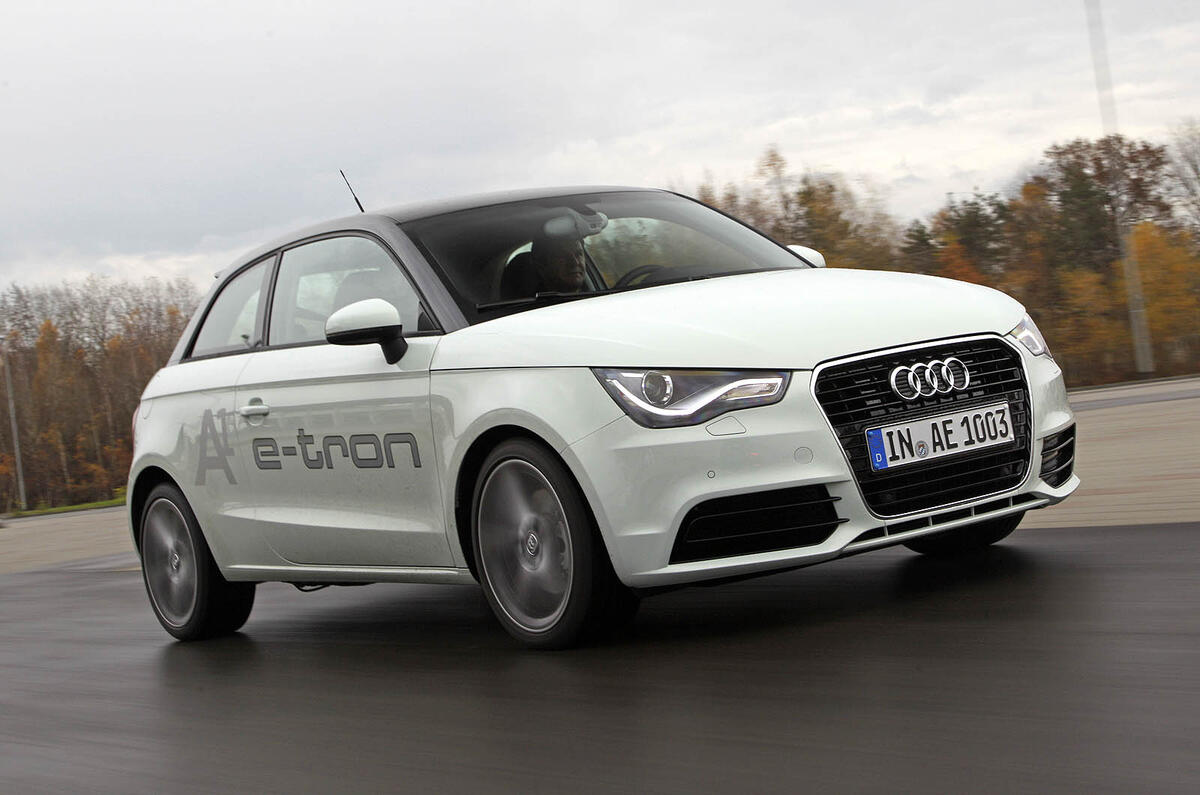What is it?
The A1 e-tron is a prototype version of the new Audi A1 hatchback and can probably be awarded the title of the first true 'range extender' electric car.
It is powered primarily by an electric motor driving the front wheels, powered by a small battery pack. However, when the battery is exhausted, a tiny Wankel engine (mounted under the boot floor) kicks in and drives a generator, which, in turn, powers the electric motor. Like nearly all electric cars, the A1 has a single speed transmission.
The combination of a (three-hour) full battery charge from the household mains, and the petrol in the car’s three-gallon tank, gives a claimed 148mpg (1.9l/100km) on the upcoming EU electric vehicle test cycle.
The motor is good for 60bhp and 111lb ft of torque on a continuous basis, but is capable of 101bhp and 177lb ft for short bursts.
In place of the usual ICE transmission, the A1 e-tron's nose not only gets the electric motor, but also houses a DC/DC inverter, the motor’s electronic control system, a battery charger, a standard 12v battery and a high voltage air conditioning compressor.
Situated in the rear half of the transmission tunnel and under the rear seats is the car’s Sanyo Lithium-Ion battery pack. A relatively modest 12kWh (half the size of battery pack used by the Nissan Leaf) will take the A1 around 31 miles in most normal conditions, arguably enough range for the average European or US commute.
What makes the A1 e-tron really special is the 'Range Extender generator module'. This is based around a tiny, 245cc, single rotar, Wankel engine. It generates a maximum 20bhp, driving a generator, which provides electricity once the battery has been run down to its lowest charge.
The Wankel engine, generator, power electronics, induction and exhaust system have been combined into a module that weighs just 65kg and fits under the A1's boot floor, without compromising luggage space. There’s even room under the floor for the Bose Hi-Fi’s bass booster.
The Chevy Volt was trailed by GM as being a range extender but, in certain high-speed situations, the Volt's engine can be coupled directly to the car’s electric motor. The A1 e-tron, however, is a true range extender in that the engine is not connected in any way to the wheels.
This completely new drivetrain has not changed the A1 in any significant way. The only external differences are the Carbon Fibre Reinforced Plastic roof panel and wheels. Compared to the massively compromised Mini E, the A1 e-tron is in another league.
What's it like?
Genuinely exceptional. Even though our test drive was on a circuit, it's hard to believe that the e-tron is not showroom ready. In fact, much of development was completed in virtual reality and real-world trials with members of the public began in Paris this summer.
In pure electric mode it is swift and quiet and handles very tidily. Despite the extra weight of the range extender running gear, the A1 had enough verve to be interesting.
Under hard acceleration it is satisfyingly quick and impressively noiseless. After a few laps of the circuit (which was laid out to imitate town driving) and a few full-bore accelerative runs, I lamented to the engineer in the passenger seat that 'I hadn't got the Wankel engine to kick in'.





















Join the debate
Add your comment
Re: Audi A1 e-tron
And at the other extreme, the 33mpg A1 Quattro...
Re: Audi A1 e-tron
Re: Audi A1 e-tron
One would have to be very ill-informed to buy this.
A 12kWh battery pack has the energy capacity of 1,09 litres of diesel. Double that to take into account thermal efficieny losses of the diesel engine. So you buy an A1 that after it has depleted its 2-litre-fuel tank-equivalent is limited to its range extender. That 20hp engine output means about 15hp output by the electrical engine. You'd be lucky to get to 50mph, ever. I can't wait to mock the first fool who discovers the results of this clash between physics and marketing, limping home at half the speed of a Citroen 2CV. Or, more likely, to curse the same fool for being an obstruction hazzard.L It is just the usual dazzle-people-with-the-numbers game, leading to an embarassingly corrupted product. And that is not innovative.